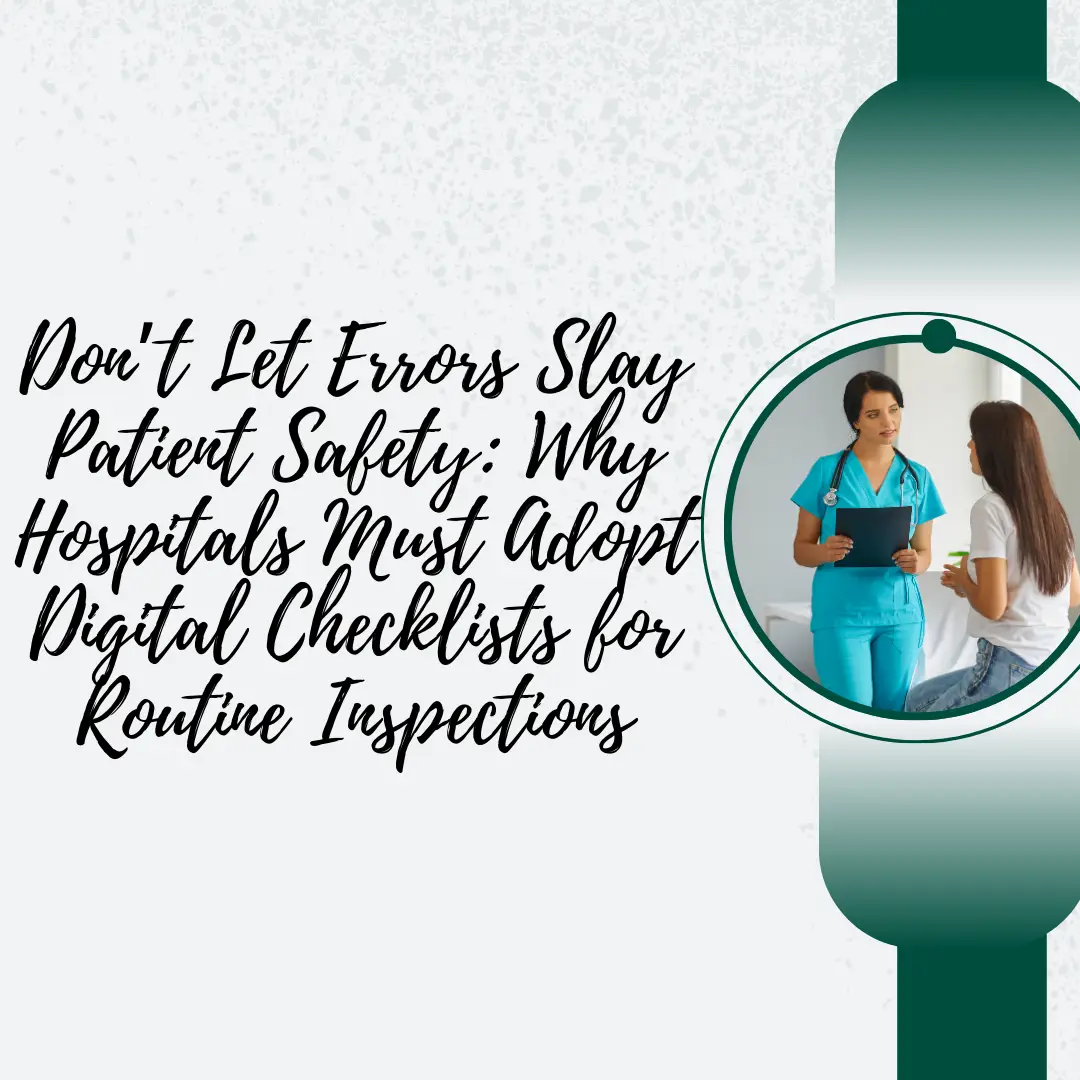In today’s rapidly evolving healthcare environment, patient safety is more critical than ever. The complexity of modern hospital systems coupled with the increase errors demands innovative solutions. Hospitals face challenges that directly impact patient well-being, regulatory compliance and overall operational efficiency routine inspections have emerged as a powerful tool to reduce medical errors, improve compliance and drive efficiency across hospital operations.

Identifying the problem: The challenges in traditional Inspections methods
Traditional paper-based checklists and manual inspections have been the norm in many hospitals. However, these methods present significant drawbacks:
Human error: Manual data entry, misinterpretations, and oversight can lead to incomplete checklists, allowing critical steps to be missed.
Data inconsistency: Paper records can be lost, damaged or misfiled which leads to discrepancies in patient records and inspection logs.
Delayed reporting: The time required to manually compile, analyse and distribute paper checklists delays Critical remediation efforts.
Inefficient Resource Allocation: staff time consumed in repetitive manual tasks can be better allocated to direct patient care or quality improvement initiatives.
The consequences of these issues are profound. For example, in one recent incident at a mid-sized hospital, a failure to verify sterilization procedures due to incomplete contributed to an outbreak of hospital acquired infections (HAIs), resulting in extended hospital stays and significant regulatory fines. Such real-world examples trigger need for a robust, digitally driven approach to patient safety protocols.

Digital transformation Advantages
Digital checklists are revolutionizing how Hospitals conduct routine inspections. By leveraging electronic tools, healthcare facilities can streamline workflows, enhance improve patient outcomes. The benefits of digital transformation in healthcare are well documented.
Advantages
Error Reduction: Automated systems that feature reminders, alerts and predefined protocols significantly reduce the likelihood of errors, A study by National Innovation (2021) demonstrated a 40% reduction in human error instances in facilities that adopted digital checklists.
Real – Time Data Access: Digital checklists provide immediate access to inspection data, allowing hospital administrators to generate real time reports
Enhanced compliance: Digital systems are easier to audit and verify, ensuring that hospitals meet regulatory standards. The healthcare compliance journal (2021)-improvement in audit outcomes for hospitals making the digital shift.
Data-driven Insights: Aggregating inspections data over time can reveal trends and patterns, thereby allowing hospitals to target systemic issues.

How digital checklists reduce Medical Errors and Enhance the compliance
One of the most significant benefits of digital checklists is their ability to standardize routine inspections procedure. These systems help in:
Standardizing Inspections: digital Checklists ensure that every critical step is verified. Unlike manual methods, they prevent deviation from standardized protocols risk of oversight.
Automated Alerts and reminders built in alerts signal when upcoming or overdue tasks require attention, ensuring staff adhere to inspection schedules.
Immediate documentation: Every inspection action is recorded in real time. This ensures a detailed and accurate log, which can be used for follow-ups and audits
Enhanced collaboration: Digital platforms allow real-time sharing of inspection data across departments, improving interdisciplinary communication and allowing the response when issues are flagged.

Recent healthcare studies supporting digital transformation Benefits
National Institute of Health innovation (2021)- this study evaluated several hospitals that transitioned from paper based to digital checklists systems a 40% decline in errors related to routine inspections. The study highlighted that digital checklist supported real time checks and facilitated rapid issue identification missed steps during critical processes.
Measurable Outcomes from Digital Transformation Initiatives
To convince stakeholders of the benefits associated with digital checklists, it is imperative to set measurable outcomes. Hospitals that have transitioned to digital systems flagged and addresses promptly.
Error reduction: Hospitals have reported reductions in documented errors by up to 40% within the first year.
Efficiency Improvements: Digital checklists can reduce the time spent on inspections by an average of 25% allowing staff to focus more on patient centered activities.
Audit and compliance Score: enhanced data integrity and traceability contribute to improved audit results- with some hospitals witnessing a 35% improvement in related scores post digital transformation.

The transformation from traditional paper-based inspection methods to digital checklists represents a critical evolution in hospital operations. By embracing digital technology can drastically reduce errors, improve patient safety and ensure compliance with regulatory standards.
For hospital administrators and healthcare leaders, the time to act is now. By following a structured, step by step plan-from a thorough needs assessment and engaging the stakeholders to piloting and then scaling digital solutions- hospitals can realize measurable improvements and foster an -organizational culture where patient safety is important.
Ultimately, the move to digital checklists is more than an administrative upgrade; it is an essential investment in quality care and patient safety. With clear, actionable steps to implement digital checklists systems, healthcare institutions have an opportunity to lead the way in digital transformation- ensuring errors are minimized

